Menu
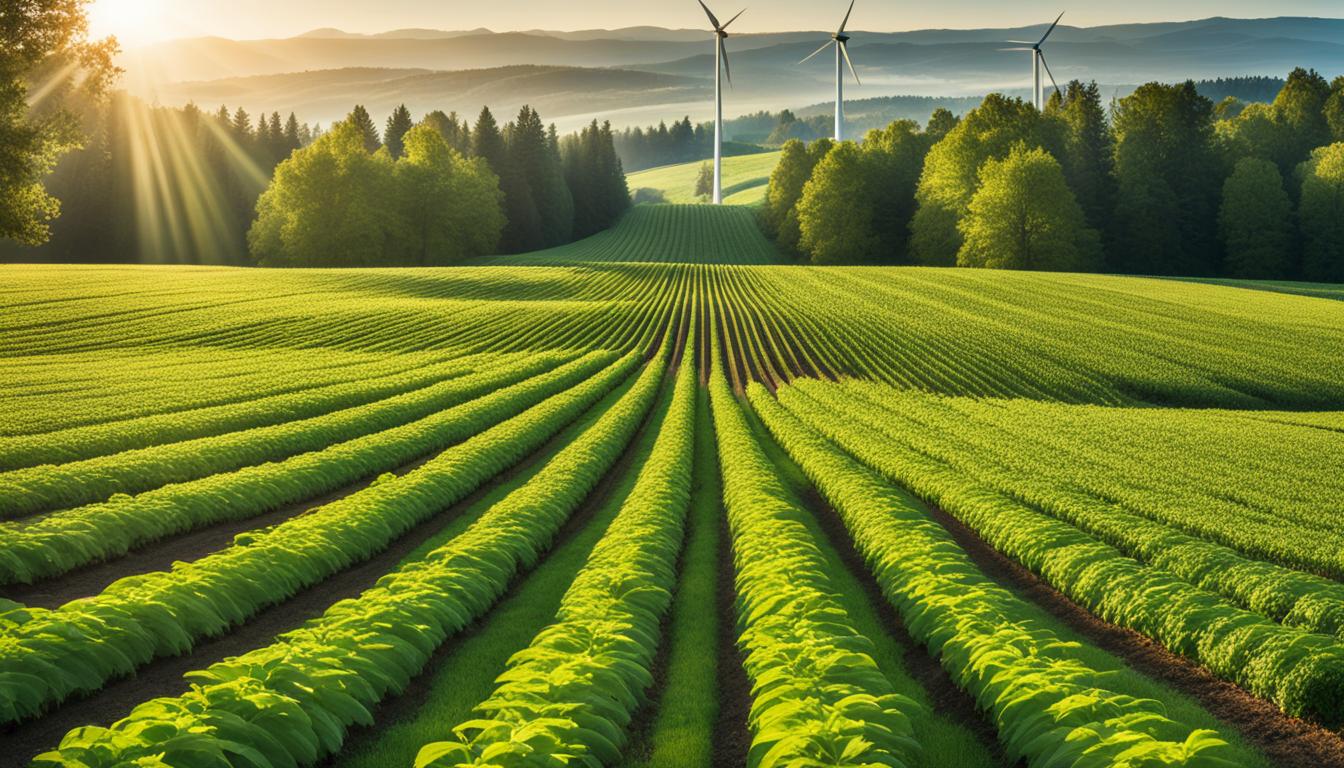
Healthy soil can reduce what growers need to add. It’s full of organic matter and has a good structure. This is a key point for those supporting sustainable farming. It helps the soil stay healthy, matters for the environment and makes land strong.
The USDA gives advice on how to care for soil based on your own needs. They suggest less moving around of the soil, keeping it covered, and promoting lots of different plants and animals. Such an approach makes crops grow better and helps our planet more.
For more insights on how to manage soil well, check out Alltech’s blog on sustainable soil management.
Starting sustainable soil management is key for good crop growth. Healthy soil is full of organic matter and holds nutrients well. This cuts down on using outside products and makes plants strong against tough conditions. It helps both farmers and gardeners.
Every year, the world loses 24 billion metric tons of soil to erosion. Thirty percent of Earth’s soil is now damaged. In China, many agricultural lands don’t meet high standards. Good soil health is essential for farmers’ success and fighting poverty.
To make soil better and lasting, we can add more organic matter. Things like cover crops, compost, or manure are great for this. They make the soil healthier and reduce the need for chemical help. This approach tackles big issues like climate change.
The United Nations says soil is very important for many global goals. It’s part of plans for health, agriculture, clean water, and more. Sharing what we know about soil is crucial for these plans to work. A smart way to manage soil nutrients, including using the right amount at the right time, is key.
Testing the soil often is smart, to spot what’s lacking and avoid too much of some nutrients. This helps add what plants really need without overdoing it. Knowing the soil’s condition helps make sure it stays fertile for a long time.
Healthy soil is key for farming that lasts. It helps crops grow and stops soil from eroding. This way, farmers can farm in a way that keeps going for the future.
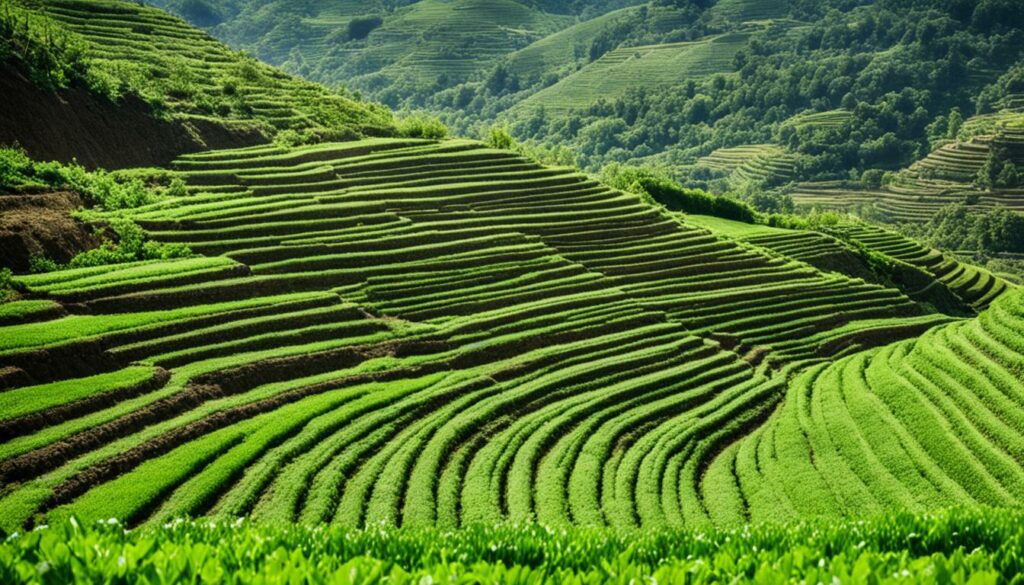
Farmers need to save water for their land to be sustainable. Good soil lets water soak in better, so it stays around longer. This cuts down the need to water crops and keeps the soil moist. It also means less water washing away chemicals into rivers.
Healthy soil is also important for stopping it from being blown or washed away. Half of all soil used in farming is already in bad shape. Methods like not ploughing and planting cover crops keep the soil where it should be. These ways protect the soil from bad weather, keeping it rich and useful.
Bad soil can hurt a country’s money-making from farming. It could cost up to $23 million around the world by 2050. But, by looking after the soil, this problem can be lessened. This means farms can keep on going well into the future.
| Statistics | Details |
|---|---|
| Food Production | 95% of food production is soil-based |
| Micronutrient Deficiencies | Over 2 billion people experience micronutrient deficiencies |
| Soil Carbon | Soil contains over three times the amount of carbon in the earth’s atmosphere |
| Agricultural Soil Degradation | More than 50% of agricultural soils are moderate to highly degraded |
| Cost of Soil Degradation | Soil degradation could cost $23 million by 2050 |
Keeping our soil healthy is very important. There are three main types of soil disturbance: biological, chemical, and physical. Overgrazing is one example of biological disturbance. It can turn lands into deserts and reduce their ability to grow crops. Adding too many synthetic fertilisers and pesticides is an example of chemical disturbance. This can harm the tiny creatures in the soil, which we need for growing plants. Physical disturbance comes from activities like ploughing, which can make the soil too hard.
Choosing to till the land less can help farmers a lot. It lets water and air get into the soil easily, reducing flooding and saving organic matter. It also stops soil from getting a hard layer on top. Not tilling so much saves money on fuel and labour. This is good for the planet because it uses less resources.
Adding animals to the farm, but making sure they don’t eat too much, helps stop biological problems. Having different plants together and using some plants to cover the ground helps with chemicals. These plants can also stop bugs, make the soil better, and mean less chemicals are needed to kill weeds.
To prevent the soil getting too hard, farmers should not work on it when it’s wet and avoid driving machines over it too much. Putting manure under the soil is a gentle way to fertilise. Growing plants that come back every year and having bushes to block the wind can stop the soil from blowing away or getting hard.
“No-till farming boosts carbon sequestration rates, significantly contributing to climate change mitigation. Better water retention from no-till methods means less irrigation is needed, saving valuable water resources,” says a recent study.
Using less tilling keeps the soil in a better shape, reducing the chances of it being washed or blown away. This is very useful in areas that often have a lot of rain or wind. Cutting down to no-till can save farmers a lot of money and energy because they need to buy less fuel and fewer machines.
| Benefits | Reduced Tillage | No-Till Farming |
|---|---|---|
| Water Retention | Increased | Significantly Increased |
| Erosion Control | Effective | Highly Effective |
| Fuel and Labour Savings | Moderate | High |
| Soil Organic Matter | Protected | Enhanced |
| Nutrient Loss | Reduced | Minimal |
Changing how we farm needs thinking and planning. But the benefits are worth it. Farmers who choose these ways to work the land will have better farms over time. Their lands will be more productive and strong against problems.
Effective methods to increase soil cover are vital for keeping soil safe, stopping erosion, and making soil healthier. To improve soil cover, farmers should do things like plant cover crops, use organic mulch, and leave old crop remains. These actions help make the soil strong and fertile, supporting farming that can last.
Cover crops like clover, rye, and vetch are great for the soil. They add carbon and organic stuff to the soil, making it better for water and nutrients that future crops need. These crops also help manage soil nutrients by using up leftover nitrogen. This means nutrients don’t just wash away and the soil gets to keep them. It also helps create a place where many different organisms, like earthworms, can live, which is good for the soil.
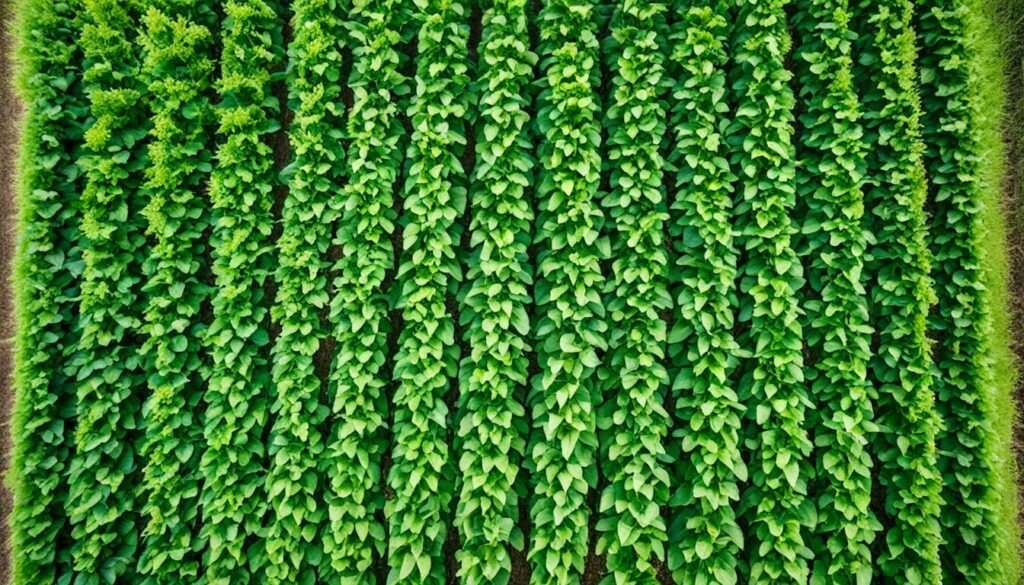
Mulching is when you cover the soil with things like straw, leaves, or compost. It keeps the soil moist, cool, and ensures soil animals are safe in tough weather. It cuts down on water that evaporates from the soil, meaning less need for watering crops. Mulch also adds organic matter to the soil, making it richer and better for plants to grow.
After harvesting, leaving some of the plants behind can do a lot of good. It protects the soil from wind and water that can wash it away. These left plants also add more organic matter back to the soil, which makes the soil structure and health better. It supports a cycle where soil gets more and more healthy, thanks to the help of tiny organisms that live in the soil.
| Practice | Benefits |
|---|---|
| Planting Cover Crops | Improves soil moisture, enhances nutrient availability, reduces erosion, and promotes soil biodiversity. |
| Using Organic Mulch | Maintains soil moisture, reduces soil temperature, protects soil organisms, and increases organic matter content. |
| Leaving Plant Residue | Protects against erosion, enhances organic matter, improves soil structure, and supports soil microorganisms. |
To wrap up, using cover crops, mulching, and not clearing fields completely after harvest can greatly help the soil. These steps encourage farming that is kind to the earth and keeps the soil able to grow food for a long time.
Encouraging soil biodiversity is key to keeping Earth’s ecosystems in balance. It’s vital for boosting crop growth too. Nearly a quarter of Earth’s species live in the ground. So, the variety of life in the soil is crucial for healthy farms. This soil diversity fights off diseases and powers up plant growth.
Soil wildlife is essential in stopping diseases. It makes it hard for harmful bugs to grow, cutting down diseases. A mix of different tiny bugs fights off bad ones, lessening the need for chemicals. This keeps farms both healthy and green.
Digging deeper, soil life is friends with plant growth. Many tiny creatures help move nutrients around, keeping plants well-fed. Just a bit of soil can hold billions of these helpers. Adding trees to farms boosts plant growth when prices on chemical foods soar. So, it’s clear, more types of life in soil mean better farms.
| Benefit | Impact on Agriculture | Example |
|---|---|---|
| Disease Prevention | Reduction in soil-borne diseases through competitive exclusion by beneficial microbes | Natural outcompetition of harmful pathogens |
| Improved Nutrient Cycling | Enhanced nutrient availability to plants | Up to 6 billion microorganisms in a teaspoon of topsoil |
| Enhanced Plant Growth | Increased agricultural productivity | Agro-forestry practices in Guatemala |
In livestock-crop integration, both the soil and farm’s output benefits. Manure is key here, adding valuable nitrogen to the soil. For example, a 100-cow dairy farm’s manure is valued over $20,000 yearly. Similarly, manure from a 100-sow operation is worth about $16,000 a year. And from a 20,000 bird broiler operation, manure brings in around $6,000 annually.
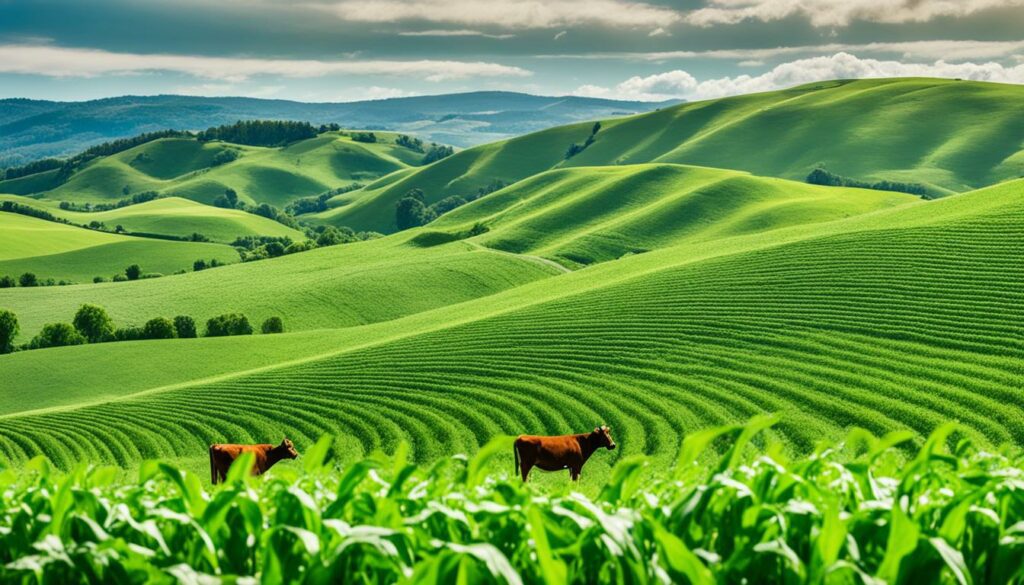
Manure helps the soil by giving it important nutrients again. The solid type has about 20% dry matter, and the liquid form is between 2% and 12%. By letting animals graze, these nutrients naturally mix with the soil. Many farmers now also make compost from manure. This helps keep the nutrients and reduces the waste that must be spread on fields.
Studies show that having livestock on farms grows the amount of organic matter in the soil. This makes the soil hold more water. For example, fields growing corn constantly without manure or fertiliser have very low organic matter, at 1.0%. But, fields that get barnyard manure every year have 2.3% organic matter. Fields using N-P-K fertiliser reach 1.9%. Clearly, using livestock in a smart way is very important.
“Cover crops combined with livestock grazing have been proven to increase yields and improve soil organic matter compared to continuous corn or corn with cover crop systems.”
Livestock that graze can help with pest and weed control. They eat weeds on empty fields and keep the ground moist. This method, with others like changing the crop every year, keeps the soil healthy. It also helps to grow better crops year after year.
Here is how the value of manure looks on different farm sizes:
| Farm Type | Annual Manure Value |
|---|---|
| 100-cow Dairy Farm | $20,000 |
| 100-sow Operation | $16,000 |
| 20,000 Bird Broiler Operation | $6,000 |
It’s vital to keep living roots in the soil all year for healthy soil and good crops. This method helps with recycling nutrients and keeps the soil steady. It’s a key part of farming that respects the environment. Activities like having more crops and shorter breaks without planting help the soil stay strong.
By not leaving the field empty, we keep it working with different plants, including cover crops. This stops the soil from losing nutrients. For example, adding Cahaba vetch to the mix gives soil a living root all year. This boosts soil nutrients.
Using many different types of crops is important. It helps keep the soil fertile and the ecosystem healthy. Each plant gives the soil special food for good microbes. Having a mix of crops also avoids soil getting too hard and helps nutrients move better.
Also, keeping the soil covered with plants or their leftovers has many perks. It helps prevent soil from washing away, controls weeds, and lets water sink in better. These things make the soil lively and supportive of plant growth. They follow the main rules of caring for the soil: not disturbing it much, always keeping it covered, adding variety of life, and having roots in the ground all year.
Organic fertilisers like compost and managed manure are key for soil health. They ensure sustainable nutrients for crops. These additions improve soil, boost microbe activity, and give plants what they need.
Compost helps by adding organic matter to the soil. This makes the soil hold water better and lets air through. In India, adding organic materials was found to make the soil better and store carbon well.
Compost is used in amounts that suit different farms. It ranges from 10 to 35 tonnes per hectare for fresh compost and 8.8 to 14 tonnes for dry compost. This means it fits many ways of feeding nutrients to crops.
Managing manure is also crucial for soil wellbeing. Different types of animal manures offer key nutrients. For example, broiler chicken manure is rich in nitrogen and phosphorus. This is great for the soil over a long time. Adding both inorganic and organic manure helps keep the land growing well. Studies show that in tropical areas, this practice can greatly improve the soil’s ability to hold and exchange nutrients.
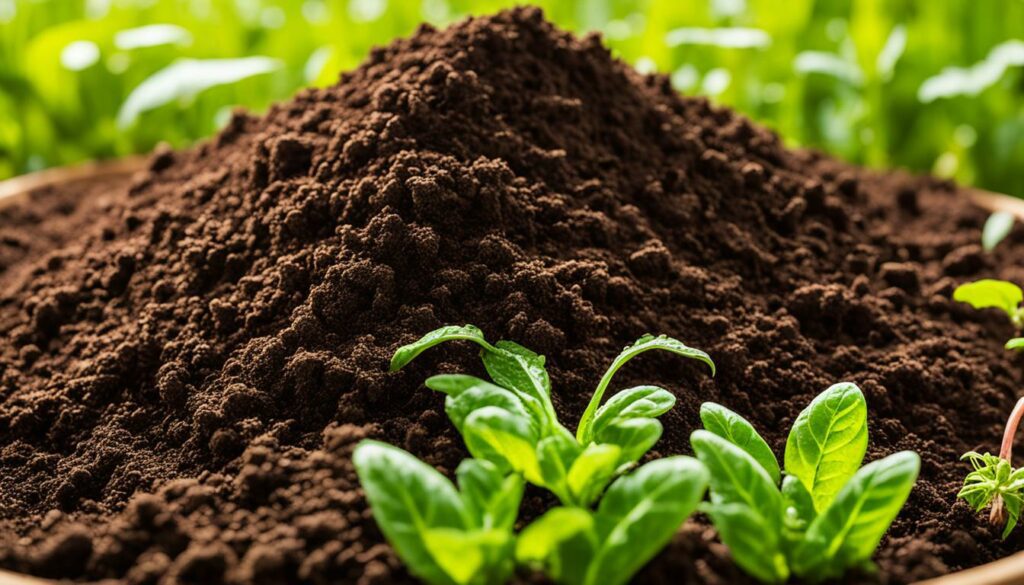
Combining fertilisers and organic residues brings big benefits. It makes soil better in many ways. For instance, areas of China improved their dry soil’s health. This happened by adding organic materials.
| Animal Manure | N (%) | P (%) | K (%) | Dry Matter (%) |
|---|---|---|---|---|
| Beef Cattle | 0.57 | 0.14 | 0.41 | 8 |
| Dairy Cow | 0.52 | 0.12 | 0.36 | 13 |
| Poultry (broilers) | 3.08 | 1.28 | 1.82 | 74 |
| Poultry (layers) | 1.68 | 1.06 | 1.20 | 42 |
| Swine (grow-finish) | 0.93 | 0.31 | 0.48 | 11 |
Animal manures each have unique nutrient contents. Mixing these into the soil caters to different crops. For instance, adding alfalfa meal improves soil. It contains the needed nutrients for good crop growth. This ability to pick the best for the land shows how vital organic materials are in farming.
Getting soil right is key for modern farming success. This includes soil tests, the right fertilisers, and managing nutrients well. These steps help crops get what they need and promote eco-friendly farming.
Testing soil is where every solid farming plan starts. It lets us find out the soil’s nutrients and structure. By testing, we can figure out what fertilisers and other additives our soil needs.
Soil testing helps by showing what nutrients are lacking or too much. This is important in knowing how to best manage soil conditions. It tells us about nitrogen, potassium, and phosphorus levels.
Once tests are done, we add specific nutrients. The “Four Rs” approach says we need to use the right amount, from the right source, where it’s needed, and when the time is right. Some key additives are:
Using composted dairy manure requires watching for salt levels to protect the soil. Adding cover crops, compost, or manure boosts soil health. It increases nutrients, which is good for the soil and helps crops grow well.
The UC Sustainable Agriculture’s Nutrient Management Center offers great advice on this. Their tips are valuable for smart, sustainable farming.
Custom fertilisation and careful soil testing are our best friends in farming. Mixing in the right nutrients helps us grow more while caring for the environment.
Knowing how nutrient cycling works is key to keeping soil healthy. It makes sure plants always have nutrients they need. This helps farming to be successful in a natural way.

Soil microorganisms are crucial for nutrient cycling. They help decay old plant parts. As they do, they turn nutrients into a form plants use directly.
This activity makes the soil better for growing. It makes sure the soil stays full of helpful nutrients.
After crops are harvested, there’s a lot of plant waste left in the fields. This waste is good food for the soil. Microorganisms living in the soil break this matter down. They turn it into nutrients plants can use.
This process offers an ongoing source of nutrients. It means we don’t need to add as many chemicals to the soil. So, it helps the environment stay healthy.
“Nutrient cycling is nature’s way of sustaining soil health, ensuring a balanced supply of nutrients for optimal plant growth.”
| Element Cycle | Description |
|---|---|
| Carbon Cycle | Carbon moves freely through the air as carbon dioxide, essential for photosynthesis and organic matter formation. |
| Nitrogen Cycle | Nitrogen, making up 78% of the Earth’s atmosphere, is fixed by microorganisms and transformed into usable forms for plants. |
| Oxygen Cycle | Oxygen, the second most abundant element in the atmosphere, circulates through respiration and photosynthesis. |
| Water Cycle | The water cycle, extending from groundwater flow to condensation, significantly influences nutrient cycling in soils. |
| Sulfur Cycle | Sulfur enters soil through organic decomposition and the deposition of sulfides, contributing to nutrient availability. |
Boosting nutrient cycles in the soil makes farming better and more Earth-friendly. It means we use less harmful chemicals. Our land stays fertile and strong for the future.
Eco-friendly farming is key to keeping our soil healthy. It helps farming stay sustainable by cutting back on harmful chemicals. This keeps ecosystems healthier and helps farms stay productive for years to come.
To cut down on pesticides, farmers are turning to natural and organic options. While synthetic chemicals can work well, they harm the environment in the long run. Techniques like no-till systems limit soil disturbance, keeping the ground healthier. Methods such as terracing and contour buffer strips stop erosion and keep soil rich and productive.
Integrated pest management (IPM) focuses on natural ways to control pests. It uses things like friendly bugs, certain farming methods, and machines to lower the need for chemicals. For example, planting cover crops like mustard can reduce pests and feed good bugs. This adds diversity to soil life, making it stronger and less vulnerable to pests.
| Practice | Effectiveness | Benefits |
|---|---|---|
| Terracing | Highly Effective | Soil Conservation, Reduced Erosion |
| No-Till Systems | Moderately Effective | Reduced Compaction, Enhanced Soil Health |
| Cover Crops | Highly Effective | Erosion Control, Soil Fertility |
| Integrated Pest Management | Highly Effective | Natural Pest Control, Enhanced Biodiversity |
| Windbreaks | Moderately Effective | Wind Reduction, Soil Stability |
Preserving soil is key to long-term farming success. This is because farming practices can lead to soil erosion. This erosion can reduce the soil’s ability to grow plants. This then affects the food we eat and the health of the environment.
To tackle this problem, there are different ways to protect the soil. Some ways involve changing how the land looks, like terracing. Others focus on what we plant, like rotating crops. All of these methods help keep the soil healthy and able to grow food.
The right method for saving the soil depends on many factors. These include the type of soil, weather, and what you’re trying to achieve. Notably, planting cover crops can help prevent soil erosion. This is critical in keeping our water clean, as it stops harmful runoff reaching water sources.
Overcoming the challenges in soil conservation requires everyone’s effort. Educational programs and better policies can help. Also, we should keep improving how we save the soil. Doing all this will make our soil stronger, support more plant and animal life, and ensure farms can keep feeding us for years to come.
Sustainable soil nutrients help plants grow and keep the soil healthy. They include things like compost and well-managed manure. These help ensure plants get the nutrients they need in a way that’s good for the earth.
To keep your soil healthy, use methods that disturb it less. This includes techniques like not tilling as much, using cover crops, applying organic mulch, and changing up what you plant. Doing these things helps the soil stay fertile.
Nutrient cycling is key because it turns old plant material into food for new plants. This is done by tiny organisms in the soil. It makes the system able to renew itself, needing less outside help.
Organic fertilisers make the soil better by boosting its structure and the life in it. They also provide nutrients to plants in a way that’s good for the environment. Using things like compost and manure helps the soil health in the long run.
To disturb the soil less, you can use less machinery, fewer chemicals, and try not tilling the soil as often. These approaches keep the soil’s structure intact and its microscopic life healthy. This way, the land stays productive for longer.
Cover crops and organic mulch act like a blanket for the soil, keeping it safe from bad weather and holding moisture in. They also make the soil rich with nutrients and life by feeding and sheltering small creatures that are good for the land.
Having many different plants and animals in the soil stops bad bugs from getting too strong. It also helps plants grow better. So, a varied and healthy soil keeps the whole farming system in balance.
Having animals around means more natural fertiliser and helps create a system where everything supports each other. This approach is a good way to make farming last for a long time without harming the environment.
Plants’ roots keep the soil alive even when crops aren’t growing. They do this by holding the soil together and feeding the tiny organisms in it. This makes for soil that’s always ready to help new plants grow.
Good soil care starts with knowing what your soil needs and then giving it just that. This approach to farming is smart and helps the soil stay productive without using too many resources.
To use fewer chemicals, go for things like organic fertilisers and be smart about keeping pests away. This way, the soil stays healthy and your farm has less of a negative impact on nature.
To keep the soil good for the years to come, focus on keeping it full of life, balanced in nutrients, and not worn out. Use farming methods that look after the soil and it will keep on giving back to you.
To let water in the soil better, make its structure healthier with things like organic matter and cover crops. This helps the soil hold more water, fight erosion, and keep your plants well-watered.
Stop soil from being washed or blown away by always covering it, turning it as little as possible, growing other plants on it when not in use, and laying down organic mulch. These steps protect the soil and make it stronger.